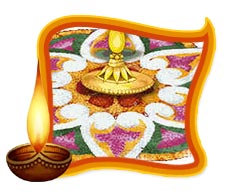 |
Rangoli is a Hindu folk art,
generally created on a floor on special festive occasions. The origin of
this art can be traced to the Puranas (works on hindu mythology).
Simply put, Rangoli means a row of colors. The tradition of Rangoli
originated in Maharastra and slowly disseminated to other parts of India.
Origin
Rangoli, also known as Kolam in South India,
Chowkpurana in Northern India, Madana in
Rajasthan, Aripana in Bihar, Alpana in
Bengal is the ancient Hindu religious floor art. According to a legend
recorded in Chitra Lakshana, the earliest treatise on
Indian painting, a king and his kingdom were steeped in sorrow at the death
of the high priest's son. Everybody prayed to Lord Brahma, who moved by the
prayers, asked the king to paint a portrait of the boy on the floor so that
he could breathe life into it. And with that the art of floor painting came
to life. And that is how rice, flour and flowers were transformed into
picturesque offerings to God in the form of floor painting.
Creative Expression
'Rangoli' is a sanskrit word which means a creative
expression of art through the use of color. In ancient India, rangolis were
used to decorate the entrances of homes, a floor-painting which provided a
warm and colorful welcome to visitors. In Indian cultures, all guests and
visitors occupy a very special place, and a rangoli is an expression of this
warm hospitality. In particular, the Diwali festival is widely celebrated
with rangolis, since at this time, people visit each other's homes to
exchange greetings and sweets.
In a rangoli, powdered colors are sprinkled on cleaned and dusted floors to
form decorations. Rangolis can be vivid, three-dimensional art complete with
shadings or they can be the traditional plain, yet as beautiful as,
two-dimensional designs. The colored powder is usually applied 'freehand' by
letting it run from the gap formed by pinching the thumb and the forefinger.
In ancient times, rangolis were actually decorations made on the entrances
and walls of houses to brighten up and add color to occasions being
celebrated, like weddings, births and significant religious days. They also
signified a warm welcome for visitors. In fact in Maharashtra, India,
housewives make them each morning. The designs would be simple and
geometrical but could invoke symbolic forms. Oil lamps (diyas) would be
placed in the rangoli to give it yet another dimension.
Thus, reflecting regional beliefs and aesthetics based on a common spiritual
plane the art of floor painting is one which has survived all influences and
retained and transmitted the spirit of Indian life.

0 Comments:
<< Home | << Add a comment